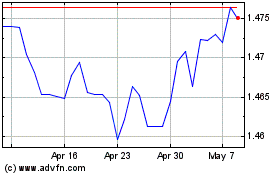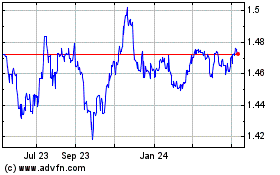U.S. Dollar Weakens On Renewed Concerns Over U.S.-China Trade War
May 30 2018 - 4:46AM
RTTF2
The U.S. dollar was lower against its most major counterparts in
the European session on Wednesday, weighed by renewed fears of a
trade war between Beijing and Washington, as the U.S. President
Donald Trump had threatened to impose punitive tariffs on Chinese
imports.
Concerns over U.S.-China trade war resurfaced, after the White
House announced Tuesday that it will impose a 25 percent tariff on
$50 billion of Chinese goods containing "industrially significant
technology."
"The United States will implement specific investment
restrictions and enhanced export controls for Chinese persons and
entities related to the acquisition of industrially significant
technology, the White House said in a statement.
The announcement came just few days ahead of a visit by Commerce
Secretary Ross to Beijing for further trade negotiations.
Data from payroll processor ADP showed that private sector
employment increased slightly less than expected in the month of
May.
ADP said private sector employment climbed by 178,000 jobs in
May after rising by a downwardly revised 163,000 jobs in April.
Economists had expected employment to increase by 190,000 jobs
compared to the jump of 204,000 jobs originally reported for the
previous month.
Later in the day, the Federal Reserve is due to release its
Beige Book, a compilation of anecdotal evidence on economic
conditions in the twelve Fed districts.
The greenback showed mixed trading against its major
counterparts in the Asian session. While it fell against the euro
and the pound, it held steady against the yen. Against the franc,
it rose.
The greenback fell to a 2-day low of 1.1647 against the euro,
after rising to 1.1519 at 10:30 pm ET. If the greenback continues
its fall, 1.19 is possibly seen as its next support level.
Survey results from European Commission showed that Eurozone
economic sentiment weakened to a 9-month low in May.
The economic confidence index dropped to 112.5 in May from 112.7
in April. This was the lowest reading since August 2017 but above
the expected score of 112.0.
Reversing from an early high of 1.3242 against the pound, the
greenback edged down to 1.3307. Next key support for the greenback
is likely seen around the 1.35 level.
Data from the British Retail Consortium showed that UK shop
prices continued to fall in May.
The BRC-Nielsen shop price index declined 1.1 percent
year-on-year in May, the biggest fall since January 2017.
The greenback dropped to 0.9881 against the Swiss franc, from a
high of 0.9935 hit at 1:45 am ET. The next possible support for the
greenback is seen around the 0.97 level.
Survey results from the KOF Swiss Economic Institute showed that
a measure signaling future turning points in the Swiss economy
declined back to its long-term average in May.
The KOF leading indicator dropped to 100 in May from 103.3 in
April, which was revised down from 105.3. Economists had expected
the index fall to 104.7.
The greenback fell to a 5-day low of 1.2950 against the loonie,
2-day low of 0.7557 against the aussie and near a 3-week low of
0.6982 against the kiwi, after having advanced to a high of 1.3040,
2-week high of 0.7476 and near a 2-week high of 0.6883,
respectively in early deals. The next likely support for the
greenback is seen around 1.26 against the loonie, 0.77 against the
aussie and 0.72 against the kiwi.
On the flip side, the greenback held steady against the yen,
after peaking at 108.98 at 7:45 am ET. At yesterday's close, the
pair was worth 108.75.
Survey data from Cabinet Office showed that Japan's consumer
confidence improved marginally in May.
The seasonally adjusted consumer confidence index rose to 43.8
in May from 43.6 in April. The index was forecast to rise to
43.9.
Looking ahead, at 10:00 am ET, the Bank of Canada announces its
decision on interest rates. The BoC is widely expected to keep
borrowing costs unchanged at 1.25 percent.
The Swiss National Bank Chairman Thomas Jordan will give a
speech titled "Innovation and Entrepreneurship: Success Factors in
a Changing Economic World" at the De Vigier Foundation Awards
Ceremony, in Switzerland at 10:45 am ET.
The Federal Reserve's Beige book report will be out at 2:00 pm
ET.
Euro vs CAD (FX:EURCAD)
Forex Chart
From Mar 2024 to Apr 2024

Euro vs CAD (FX:EURCAD)
Forex Chart
From Apr 2023 to Apr 2024
